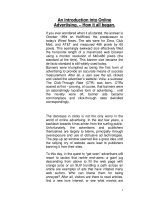led zeppelin. the origin of the species how, why and where it all began
Bạn đang xem bản rút gọn của tài liệu. Xem và tải ngay bản đầy đủ của tài liệu tại đây (12.06 MB, 305 trang )
LED ZEPPELIN
The Origin Of The Species
LED ZEPPELIN
The Origin Of The Species: How, Why And Where It All Began
by Alan Clayson
A CHROME DREAMS PUBLICATION
First Edition 2006
Published by Chrome Dreams
PO BOX 230, New Malden , Surrey
KT3 6YY, UK
W W W. C H R O M E D R E A M S . C O . U K
ISBN 1 84240 345 1
Copyright © 2006 by Alan Clayson
Editorial Director Rob Johnstone
Editor Rebecca Candotti
Cover design Sylwia Grzeszczuk
Interior design Marek Krzysztof Niedziewicz
Front and Back Cover
Barry Plummer
Inside Photos
Barry Plummer
LFI
Starfile
Alan Clayson Archive
All rights reserved. No part of this book covered by the copyright hereon may be reproduced
or copied in any manner whatsoever without written permission, except in the case of brief
quotations embodied in articles or reviews where the source should be made clear. For more
information please contact the publishers.
A catalogue record for this book is available from the British Library.
LED ZEPPELIN
The Origin Of The Species
How, Why And Where It All Began
A L A N C L AY S O N
To the artist otherwise known as Wreckless Eric
‘The distance is nothing. It is only the first step that counts’
Mme. du Deffand
CONTENT
About The Author
11
Prologue: The Borrowers 15
1. The Crusader 21
2. The Art Student 41
3. ‘Little Jim’ 47
4. The Night-Timer 65
5. The Blackwater Sideman 87
6. The Listener 97
7. The Spider 117
8. The Facilitator 133
9. The Black Snake Moaner 139
10. The Yardbird 153
11. The Wayfarer 165
12. The Time Server 175
13. The Bandsman Of Joy 187
14. The New Yardbird 195
15. ‘Prince Mario’ 201
16. ‘Bob Plante’ 207
17. The Thunderbird 211
18. The Wishful Thinker 217
19. The Negotiator 223
20. The Occultist 225
21. The Group 237
Epilogue: The Now And Zen Men 255
Discography 273
Index
277
ABOUT THE AUTHOR
Born in Dover, England in 1951, Alan Clayson lives near Henleyon-Thames with his wife Inese. Their sons, Jack and Harry, are both
at university.
A portrayal of Alan Clayson by the Western Morning News as the
‘A.J.P. Taylor of the pop world’ is supported by Q’s ‘his knowledge
of the period is unparalleled and he’s always unerringly accurate.’
He has penned many books on music - including the best-sellers
Backbeat, subject of a major film, The Yardbirds and The Beatles
Box - and has written for journals as diverse as The Guardian,
Record Collector, Ink, Mojo, Mediaeval World, Folk Roots, Guitar,
Hello!, Drummer, The Times, The Independent, Ugly Things and, as
a teenager, the notorious Schoolkids Oz. He has also been engaged
to perform and lecture on both sides of the Atlantic - as well as
broadcast on national TV and radio.
From 1975 to 1985 he led the legendary Clayson and the
Argonauts - who reformed briefly in 2005 to launch a long-awaited
CD retrospective - and was thrust to ‘a premier position on rock’s
Lunatic Fringe’ (Melody Maker). As shown by the existence of
a US fan club - dating from an 1992 soiree in Chicago - Alan
Clayson’s following grows still as well as demand for his talents as
a record producer, and the number of versions of his compositions
by such diverse acts as Dave Berry (in whose backing group he
played keyboards in the mid-1980s), New Age outfit, Stairway
- and Joy Tobing, winner of the Indonesian version of Pop Idol.
He has worked too with The Portsmouth Sinfonia, Wreckless Eric,
Twinkle, The Yardbirds, The Pretty Things and the late Screaming
Lord Sutch among many others. While his stage act defies succinct
description, he has been labelled a ‘chansonnier’ in recent years
for performances and record releases that may stand collectively
as Alan Clayson’s artistic apotheosis were it not for a promise of
surprises yet to come.
Further information is obtainable from w w w.a la n cla y so n .c o m
11
OTHER BOOKS BY ALAN CLAYSON
OTHER BOOKS BY ALAN CLAYSON
Call Up The Groups: The Golden Age Of British Beat, 1962–67
(Blandford 1985)
Back In The High Life: A Biography Of Steve Winwood
(Sidgwick and Jackson 1988)
Only The Lonely: The Life And Artistic Legacy Of Roy Orbison
(Sanctuary 1989)
The Quiet One: A Life Of George Harrison (Sanctuary 1990)
Ringo Starr: Straight Man Or Joker? (Sanctuary 1991)
Death Discs: An Account Of Fatality In The Popular Song
(Sanctuary 1992)
Backbeat: Stuart Sutcliffe, The Lost Beatle (with Pauline Sutcliffe;
Pan Macmillan 1994)
Aspects Of Elvis (ed. with Spencer Leigh; Sidgwick and Jackson 1994)
Beat Merchants (Blandford 1995)
Jacques Brel (Castle Communications 1996)
Hamburg: The Cradle Of British Rock (Sanctuary 1997)
Serge Gainsbourg: View From The Exterior (Sanctuary 1998)
The Troggs File: The Official Story Of Rock’s Wild Things
(with Jacqueline Ryan; Helter Skelter 2000)
Edgard Varese (Sanctuary 2002)
The Yardbirds (Backbeat 2002)
13
OTHER BOOKS BY ALAN CLAYSON
John Lennon (Sanctuary 2003)
The Walrus Was Ringo: 101 Beatles Myths Debunked (with Spencer
Leigh; Chrome Dreams 2003)
Paul McCartney (Sanctuary 2003)
Brian Jones (Sanctuary 2003)
Charlie Watts (Sanctuary 2004)
Woman: The Incredible Life Of Yoko Ono (with Barb Jungr and
Robb Johnson; Chrome Dreams 2004)
Keith Richards (Sanctuary 2004)
Mick Jagger (Sanctuary 2005)
Keith Moon: Instant Party (Chrome Dreams 2005)
PROLOGUE: THE BORROWERS
‘There was nothing original’ - Robert Plant
Should a plumber receive a royalty every time a toilet
he has installed is flushed? On the same basis, composers can
make piecemeal fortunes. However, they can also risk losing
vast amounts of money for - often unconscious - plagiarism. As
soon as you pick out the first note after sitting down at a piano
to develop some flash of musical inspiration, you have to be on
your guard. Someone might own that note.
Lyrics might be a different matter, but surely every
combination of even the twelve semitones in the chromatic scale
have been used by now. The other day, I detected the melody of
‘Street Fighting Man’ in ‘Lyla’ by Oasis - an easy target - just as
that of ‘Simon Says’ by The 1910 Fruitgum Company is discernable in ‘Help Me Make It Through The Night’. Then there’s
The Lovin’ Spoonful’s imposition of a 1940s tune, ‘Got A Date
With An Angel’, onto their ‘Daydream’ smash; that of ‘While
My Guitar Gently Weeps’ on Roxy Music’s ‘Song For Europe’
- and, of course, The Chiffons’ ‘He’s So Fine’ on George Harrison’s million-selling ‘My Sweet Lord’, an affinity that sparked
off the most famous civil action of the 1970s.
The resulting declaration against Harrison in 1976 led
Little Richard’s publisher to claim breach of copyright in a track
from the twelve-year-old Beatles For Sale - and that rock ‘n’
roll penny-pincher Chuck Berry had already been compensated
by court order for the few syllables quoted from his ‘You Can’t
Catch Me’ - as a tribute to him - at the start of Abbey Road. In
1981, the music press intimated a howl of artistic ire from Rolf
Harris when Adam and the Ants’ UK Number One with ‘Prince
Charming’, appropriated the melody from one of his forgotten
- though not so forgotten - singles, ‘War Canoe’.
It’s less trouble to plunder traditional items from time
immemorial. One potent advantage is that these are public
domain - which means that the artists’ publishers can cream
off composing income. Such rewards, however, were often
15
LED ZEPPELIN
deserved. In 1963, there was an imaginative rocking-up of the
Cornish Floral Dance by The Eagles from Bristol, while ‘Danny
Boy’ - from the Gaelic ballad ‘Acushla Mine’ - was crucified
by Market Harborough’s answer to Tom Jones one beer-sodden
evening in the Red Lion only the other week. In the wake of
Traffic’s daring ‘John Barleycorn’ in 1970 came The Nashville Teens’ spooky adaptation of ‘Widecombe Fair’, the West
Country tale of Tom Pierce’s old mare who expires, returns as a
ghost ‘and all the night can be heard skirling and groans.’
Whether victimless theft like this or potentially litigational, there are many hours of enjoyable time-wasting to be had
in collating examples from the collected works of Led Zeppelin
more than possibly any other major act that emerged from the
British beat boom and its immediate aftermath. Much of it was
lifted from blues, classic rock and even folk sources, but, as this
saga will reveal, the group’s prehistory is as steeped in the likes
of Val Doonican, Herman’s Hermits and the most vacuous of
chart pop as with Muddy Waters, Chuck Berry and Bob Dylan
- and is at least as intriguing as a fully mobilised Led Zeppelin’s
years of optimum impact.
Moreover, throughout chapters of uneven length and
amid the loose ends and biographical cul-de-sacs, outlines
dissolve and contents merge between the gradually less separate
lives of the dramatis personnae - guitarist Jimmy Page, bass and
keyboard player John Paul Jones, singer Robert Plant, drummer
John Bonham - and let’s not forget manager Peter Grant - prior
to their coming together as Led Zeppelin in 1968.
For that Tibetan monk who’s never heard of them, Led
Zeppelin were, broadly, a rock group that rose from ‘Brumbeat’ - a blanket term for the West Midlands pop scene - and the
ashes of Swinging Sixties hitmakers, The Yardbirds. Renowned
session musician Jimmy Page had been approached to replace
departing Yardbirds guitarist Eric Clapton in 1965, but did not
join until the following autumn, initially on bass. Within weeks,
however, he had reverted to a more apposite role as co-lead
guitarist with Jeff Beck.
16
THE ORIGIN OF THE SPECIES
Following the latter’s piqued departure in 1967, a Yardbirds in commercial decline continued as a four-piece before
splitting-up in July 1968. Page and Grant - once head of The
Yardbirds’ road crew - began then to put together a New Yardbirds ostensibly to fulfil outstanding dates. Heard on the previous
incarnation’s final singles, Jones - also, like Page, the earner
of anonymous credits on numerous British-made hits - was
enlisted. Bonham and Plant, veterans of various unsuccessful
Midlands groups, were recruited too. Guided by the formidable
Grant, the four renamed themselves Led Zeppelin, and were
signed to Atlantic Records. An eponymous debut album in 1969
crept into the British Top Ten, but Grant chose to focus on the
more lucrative North American market.
Hot on the heels of the first effort, Led Zeppelin II
- containing the prototypical ‘Whole Lotta Love’ - was a US
chart-topper. Tidy-minded journalists pigeon-holed the new
sensation as the ultimate ‘high energy’ band. With Adonis-like
Plant’s lung power on a par with instrumental sound-pictures of
Genghis Khan carnage from the other three, Led Zeppelin soon
filled the market void left by Clapton’s now defunct ‘supergroup’, Cream. They also rivalled and then superceded The Jeff
Beck Group as principal role models, then and now, for countless heavy metal outfits across the globe.
Nevertheless, by 1970’s Led Zeppelin III, a quasi-pastoral
approach had infiltrated the modus operandi to a noticeable
degree, and its untitled follow-up up featured ‘Stairway To
Heaven’, a slow ballad that became an in-concert finale, and the
most spun track on post-Woodstock US radio. Yet any muted
cleverness or restraint that might have been displayed in the
studio - where they focussed almost exclusively on albums was lost to the sweaty intensity of deafening heads-down-nononsense rock during what were now less musical recitals than
uproarious tribal gatherings. To snow-blinded acclaim, often
accompanied by riot, Led Zeppelin broke attendance records
held previously not only by Cream, but also The Beatles and,
for a while, the still-functioning Rolling Stones.
17
LED ZEPPELIN
For the rest of a twelve-year existence, the ensemble
continued to headline at European outdoor festivals and,
especially, North American stadiums, despite - or because of
- Grant severely restricting television appearances and further
media exposure. His judgement proved correct, and a legend
took shape. Amid eye-stretching rumours of peculiar goings-on
behind closed doors in hotel suites and the privacy of their own
homes, the group could afford to retire from public performance
for over a year after the issue of 1973’s Houses Of The Holy.
This enabled the foundation of their own record company, Swan
Song - with signings that included The Pretty Things and Bad
Company as well as themselves - the recording of the Physical
Graffiti double-album, and preparation for more barnstorming
world tours that sold out automatically even as the punk storm
broke and subsided.
With the means to turn their every whim into audible
reality, and each member of the team from the humblest equipment-humper to the high command of Bonham, Grant, Jones,
Page and Plant was firing on all cylinders. There were as yet no
cracks in the image.
As wanted party guests of rock’s ruling class, Led
Zeppelin saw out the decade with further best-selling releases
- Presence and 1979’s In Through The Out Door - plus, as a
holding operation during a long lay-off, a semi-documentary
film, The Song Remains The Same and its soundtrack. However,
a troubled return to the stage prompted rumours of imminent
disbandmemt - and, after the sudden death of John Bonham in
1980, they did, indeed, down tools as a working band for all
practical purposes, apart from rare one-off reunions with substitute drummers. However, Coda, a 1982 of hitherto unissued
material, and, ten years later, Remasters, the first Led Zeppelin
compilation, were among posthumous marketing triumphs that
affirmed the quartet’s resonance as both figureheads and grey
eminences of late twentieth century pop - and, as a post script,
Plant and Page renewed their creative partnership for such as
1994’s No Quarter: Unledded, an album that mixed new material with overhauls of old favourites.
18
THE ORIGIN OF THE SPECIES
When researching this account, I listened hard to No
Quarter and all that had preceded it - as far back as the first singles
on which the individual members of Led Zeppelin appeared. I
also worked through the back copies of Midland Beat preserved
in the local studies department of Birmingham Central Library,
and read many of the numerous books - ranging from scurrilous
trash to well-researched, scholarly works to volumes containing
just raw data - about Led Zeppelin. Investigated also were two
spoken-word items - Maximum Led Zeppelin (Chrome Dreams
ABCD101) and Led Zeppelin: The Classic Interviews (Chrome
Dreams CIS2006 - with Page, Plant and Jones by Guitar Player
magazine’s Steven Rosen in 1977).
En route, I fanned out to the erudite likes of Brum
Rocked! (TGM, 1999) and its Brum Rocked On! sequel (TGM,
2003), Laurie Hornsby’s profusely illustrated chronicles that
that likely to prove of intense fascination whether you were
directly involved or have a general interest in Led Zeppelin and
the evolution of British rock.
Morning became evening too and I hadn’t even stopped
to eat, such is the depth and breadth of John Combe’s Get Your
Kicks On The A456 ( John Combe Associates, 2005), which deals
with Robert Plant’s home town of Kidderminster’s parochial
heroes and many also-rans who won’t mean much beyond the
Black Country - The Huskies, Norman’s Conquests or Custard
Tree, anyone? Nevertheless, the author’s commitment to his
subject and a treasury of photos, clippings and further memorabilia drives a tale that, as cultural history per se, wouldn’t
have needed associations with big names to enhance it. The
same applies to 2001’s ‘N Between Times, Keith Farley’s selfpublished oral history of the Wolverhampton group scene of
the 1960s.
For their candour and intelligent argument, thanks are in
more specific order for Dave Berry, Trevor Burton, Clem Cattini,
Tony Dangerfield, Chris Dreja, Steve Gibbons, Dave Hill, Chris
‘Ace’ Kefford, Denny Laine, Jim McCarty, Richard MacKay,
19
LED ZEPPELIN
Jacqui McShee, Dave Pegg, Brian Poole, John Renbourn, the
late Tim Rose, Paul Samwell-Smith, Jim Simpson, the late Lord
David Sutch, the late Carl Wayne and Bert Weedon.
Whether they were aware of providing information or
not, let’s have a round of applause too for Ian Ballard, Roger
Barnes, Pete Cox, Don Craine, Dick Dale, Spencer Davis, Keith
Grant-Evans, Eric Goulden, John Harries, Paul Hearne, Brian
Hinton, Garry Jones, Graham Larkbey, Johnnie Latimer Law,
Phil May, Percy Perrett, Ray Phillips, Ricky Richards, Twinkle
Rogers, Lloyd Ryan, Tony Sheridan, the late Vivian Stanshall,
Mike and Anja Stax, Andy Taylor, Dick Taylor, John Townshend,
Paul Tucker, Ron Watts, Frank White and Pete York.
It may be obvious to the reader that I have received help
from sources that prefer not to be mentioned. Nevertheless, I
wish to acknowledge them - as well as Birmingham Central
Library, Robert Cross of Bemish Business Machines, Sean
Body (of Helter Skelter), Phil Capaldi, Kevin Delaney, Stuart
and Kathryn Booth, the late Denis D’Ell, Ian Drummond, Katy
Foster-Moore, Pete Frame, Michael Heatley, Dave Humphreys,
Alun Huws, Mick and Sarah Jones, the late Carlo Little, Elizabeth McCrae, Russell Newmark, Reg Presley, Mike Robinson,
Mark and Stuart Stokes, Anne Taylor, Warren Walters, Gina
Way, Ted Woodings - and Inese, Jack and Harry Clayson.
Please put your hands together too for Rob Johnstone,
Becky Candotti, Melanie Breen and all the usual suspects
at Chrome Dreams for patience and understanding during
the writing of a book that is meant to be as entertaining as it is
academic.
Alan Clayson, January 2006
THE CRUSADER
‘It was sitting around in our living room for weeks. I wasn’t
interested. Then I heard a couple of records that really turned
me on, and I wanted to know what it was all about. This guy at
school showed me a few chords, and I just went from there’ Jimmy Page(1)
On 10 October 2005, Jimmy Page received Q magazine’s
‘Icon’ award, partly for being the prime mover in the formation
of Led Zeppelin. Indeed, just as some English history primers
start with the battle of Hastings, you could argue that the dawn of
Led Zeppelin began in 1958 when fourteen-year-old schoolboy
James Patrick Page from Epsom, Surrey, having proved himself in itinerant talent contests, was well-placed, had he wished,
to seize the ultimate prize of a spot on ITV’s Search For Stars
talent contest, hosted by Carroll ‘Mr. Starmaker’ Levis, spiritual forefather of fellow Canadian Hughie Green of Opportunity
Knocks fame.
In a clip used in those before-they-were-famous TV compilations that rear up periodically these days, interviewer Huw
Weldon thrusts a stick-mike at the regionally famous Jimmy’s
mouth. The young man expresses an enthusiasm for angling,
and, to an enquiry about his future plans, assures viewers in so
many words that he doesn’t think of the guitar as a key to a viable career. Attempting to make a living as a musician wasn’t
a sensible option for one such as him. It was a facile life, a vocational blind alley - especially if you were involved in pop.
Hardly anyone lasted very long.
While making this token nod towards common sense for
the sake. perhaps, of domestic harmony, Jimmy was more aware
than his parents that, while once the guitar had been associated
mainly with Latinate heel-clicking, it was now what Elvis Presley hung round his neck. Indeed, Scotty Moore’s plain-and-simple solos in ‘My Baby Left Me’ and, to a greater degree, ‘Baby
Let’s Play House’, Presley tracks issued in Britain in 1956 and
1957 respectively, had persuaded Jimmy Page to teach himself
21
LED ZEPPELIN
the Spanish guitar he’d been given the previous year. Handsomely endowed with a capacity to try-try again, he laboured
late into the evening, to the possible detriment of even that modicom of homework necessary to avoid a school detention the
next day.
‘I always thought the good thing about guitar was that
they didn’t teach it at school,’ smiled Jimmy, ‘Teaching myself to play was the first and most important part of my education.’ (1) If he never quite grasped sight-reading at school and
via a few private guitar lessons from a bloke in nearby Kingston, he’d still pore over perhaps ‘Skiffle Rhythms’, ‘When The
Saints Come Marching In’ (sic), ‘Simple Blues For Guitar’ and
further exercises prescribed in Play In A Day, devised by Bert
Weedon, who, decades later, was to receive an OBE for ‘services to music’.
As Baudelaire reminds us, ‘No task is a long one but the
task on which one dare not start’. Perhaps one subliminal effect of Weedon’s plebian-sounding forename was that it made
the many editions of his tutor manual - first published in 1957
- seem less daunting to Jimmy, George Harrison, Eric Clapton,
Pete Townshend, Brian May, Steve Hillage, you name ‘em, who
are reputed to have started by positioning yet uncalloused fingers on taut strings and furrowing brows over Play In A Day
before advancing to pieces by the likes of Charlie Christian and
Django Reinhardt in its Play Every Day companion.
Weedon may be seen as a role model of sorts for the teenage Page. Bert’s own adolescent self had been influenced in turn
by the ‘gypsy jazz’ of Reinhardt, who he considered ‘the greatest guitarist of all time’. Yet, during the war, a rather overawed
Bert succeeded Reinhardt in the Quintet du Hot Club de France
- where he was instructed by Stephane Grappelli to develop his
own style rather than attempt to copy Reinhardt.
By 1956, Weedon was fronting his own outfit, and had
released a maiden single, ‘Stranger Than Fiction’, but only his
theme to television’s $64,000 Question sold even moderately
before ‘Guitar Boogie Shuffle’ cracked the Top Ten. Subsequent
hit parade entries, however, proved less lucrative than his guesting
22
THE ORIGIN OF THE SPECIES
on countless discs by bigger stars. Though he’d back visiting
North Americans such as Frank Sinatra, Rosemary Clooney and
Nat ‘King’ Cole - later, the subject of a Weedon tribute album his bread-and-butter was accompanying domestic artistes from
Dickie Valentine and Alma Cogan to the new breed of Presleyesque teen idols such as Tommy Steele, Cliff Richard and Billy
Fury.
As well as having first refusal on, more or less, all London sessions until well into the next decade, Weedon solo 45s
tended to hover round the middle of the Top 40. Though The
Shadows were dismissive of his rival version of their chart-topping ‘Apache’ in 1960, they paid their respects to Bert by penning ‘Mr. Guitar’, his singles chart farewell. Nevertheless, he
remained in the public eye through a residency on ITV’s Five
O’Clock Club, an ITV children’s series - as well as a remarkable
1964 spot on Sunday Night At The London Palladium on which
he showed that he could rock as hard as anyone.
This was noted by Jimmy Page, who’d already taken to
heart the kind of advice that Weedon would still be imparting in
his eighties: ‘Whether you’re an old professional or a raw beginner, basically, it’s all about continual practice. I practice for at
least an hour every day - because it’s not a chore, but a pleasure.
I love playing the guitar. Last night, for instance, I spent an hour
and a half mastering a riff by quite a well-known pianist by applying it to the fretboard. If you’re a musician - not necessarily
a guitarist - you should always try something you can’t do, and
extend your scope by practicing until you can do it. Then find
something else you can’t do. Even at my age, I’m still learning.
You must never stop wanting to be a better musician.
‘Finally, even if you just play a scale, put everything
you’ve got into it, get a nice tone and make it melodic. If you’re
not prepared to put your heart and soul into it, don’t bother.’
While Jimmy did not consider himself a natural musician, his fingers hardened with similar application to the fretboard - to the degree that he forged the beginnings of both a
personal style and, despite what he told Huw Weldon, an as yet
23
LED ZEPPELIN
unspoken fancy that he’d like to make his way in the world as an
entertainer. He didn’t mention it immediately as he wasn’t sure
how mum and dad would react.
Though he had a serviceable singing voice too, Jimmy
could not see himself donning the mantle of domestic Elvis
Presley. He felt more of an affinity to Scotty Moore and his successor, James Burton, the lead guitarist who Elvis shared with
Ricky Nelson (whose 1961 hit, ‘Hello Mary Lou’, was to be one
of Led Zeppelin’s more light-hearted, if very occasional, repertory selections). Besides, Page and fellow teenagers had been
so generally dismayed by most indigenous ‘answers’ that the
sounds of the real thing on disc were preferable to such an act if
he was booked for a local dance. Such a person rather than the
gramophone was the intermission, an opportunity to go to the
toilet, talk to friends, buy a soft drink.
If anyone bothered listening, it was for the wrong reasons as the too-innocuous perpetrator in struggling to scale the
heights of his aspirations, afforded glimpses of unconscious
comedy to his audience as he gyrated like he had a wasp in his
pants, yeahing and uh-huhing his way through ‘All Shook Up’,
the first UK Number One by ‘this unspeakably untalented, vulgar young entertainer’ - as a television guide had described
Elvis after an appearance on The Ed Sullivan Show - the US
equivalent of Sunday Night At The London Palladium - which
would only risk screening him from the waist up. In the UK,
Methodist preacher (and jazz buff) Dr. Donald Soper wondered
‘how intelligent people can derive satisfaction from something
which is emotionally embarrassing and intellectually ridiculous.’(2) Of ‘Heartbreak Hotel’, Presley’s first million-seller,
too, the staid New Musical Express - the ‘NME’ - wrote, ‘If you
appreciate good singing, I don’t suppose you’ll manage to hear
this disc all through.’(3) What more did Elvis need to be the rage
of teenage Britain?
The exploitation of Elvis Presley - with whom Jimmy
Page shared the same birthday - in the mid-1950s was the tip of
an iceberg that would make more fortunes than had ever been
realised since Edison invented the phonograph. All manner of
24









